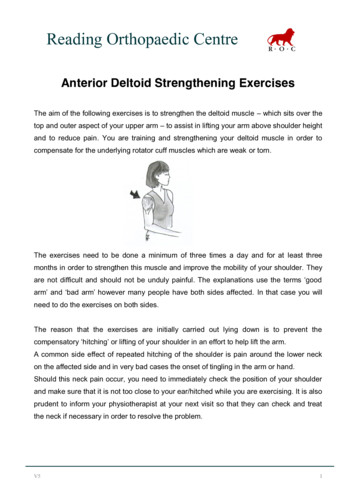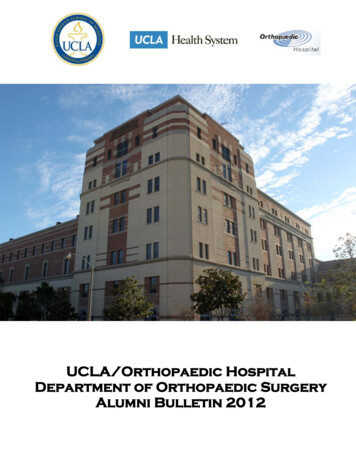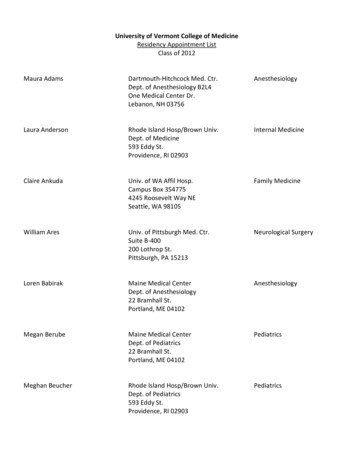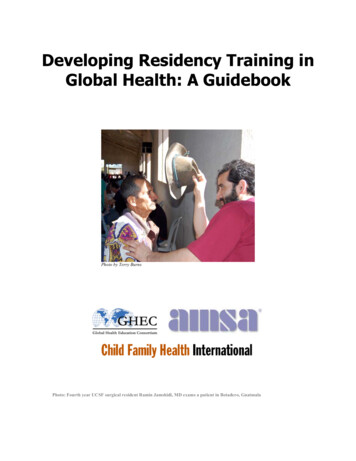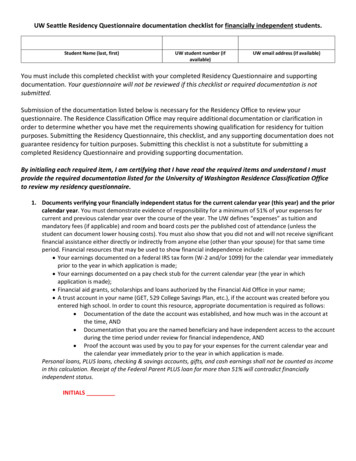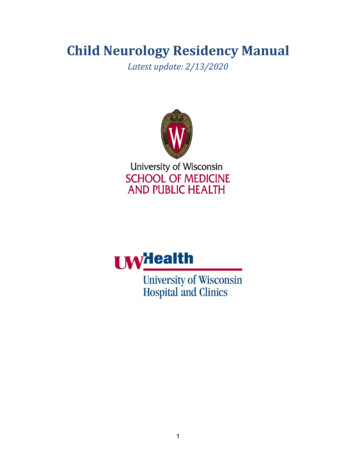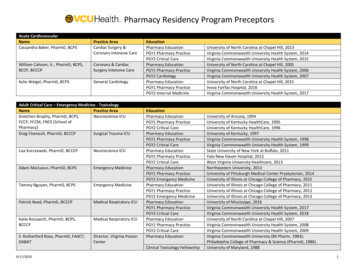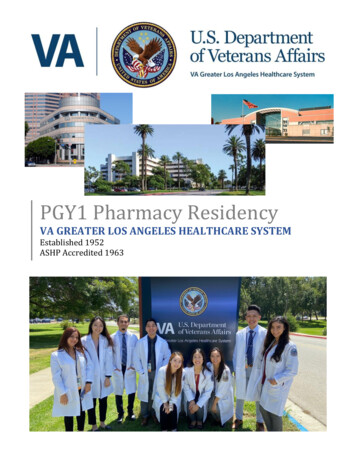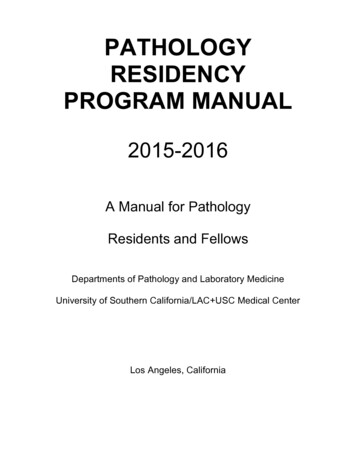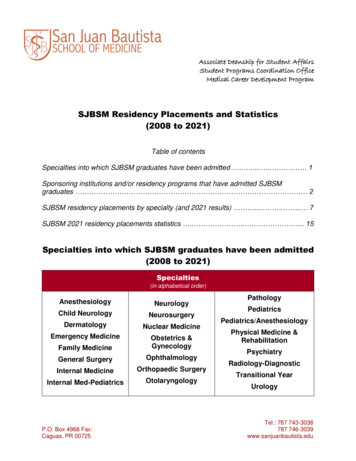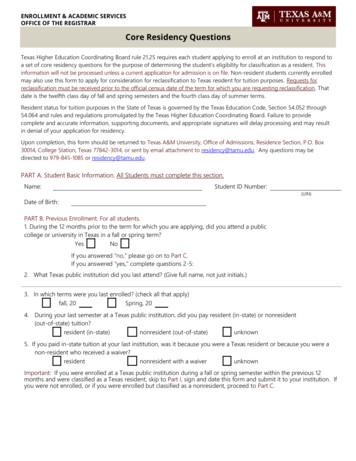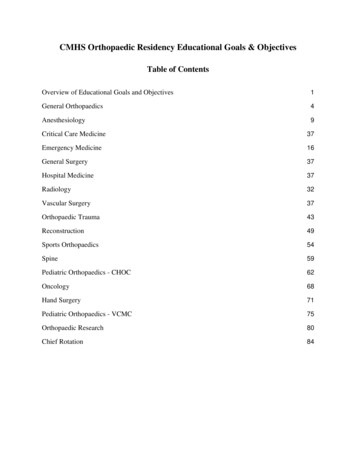
Transcription
CMHS Orthopaedic Residency Educational Goals & ObjectivesTable of ContentsOverview of Educational Goals and Objectives1General Orthopaedics4Anesthesiology9Critical Care Medicine37Emergency Medicine16General Surgery37Hospital Medicine37Radiology32Vascular Surgery37Orthopaedic Trauma43Reconstruction49Sports Orthopaedics54Spine59Pediatric Orthopaedics - CHOC62Oncology68Hand Surgery71Pediatric Orthopaedics - VCMC75Orthopaedic Research80Chief Rotation84
Overview of Educational Goals and ObjectivesDescriptionOrthopaedic residents rotate on 10 different orthopaedic services and 7 non orthopaedic rotationsduring their time at CMH. The majority of the resident’s time will be spent at the base hospital,Community Memorial Hospital (CMH), with rotations also taking place at Ventura CountyMedical Center (VCMC), Children’s Hospital of Orange County (CHOC), Cedars-Sinai MedicalCenter (CSMC) and at various outpatient practices and surgery centers. The orthopaedicrotations consist of general orthopaedics, trauma, joint reconstruction, sports, spine, pediatrics,oncology, hand, research/elective, and chief months.Resident Role and ExpectationsResidents will act as a key member of the care team, participating in clinical diagnosis andtreatment of a myriad orthopaedic conditions, requiring both nonoperative and surgicalinterventions. This clinical experience will take place under the supervision and guidance of theteaching attending staff. As residents progress through the program, they gain gradualindependence in patient care and under supervision develop the skills and clinical acumen topractice independently as an attending orthopaedic surgeon. By the time residents are in thechief/PGY5 year, they are expected to function at the level of a junior attending physician butstill have the supervision and guidance of the attending faculty.ReadingsSpecific readings are listed under the various servicesContactSarah PerryResidency CoordinatorGoals and ObjectivesI.At completion of the orthopaedic residency program, the resident will demonstrate themedical knowledge, patient care, professional, and communication skills necessary tofunction independently as an attending orthopaedic surgeon. Through a broad range ofvaried clinical experiences and under the instruction and guidance of the teachingattending faculty, residents will demonstrate the ability to perform self-directed learning,evaluate their own patient outcomes and performance, and work effectively in numerous1
health care delivery settings. The resident will receive regular evaluations from theattending staff and incorporate feedback provided to continuously improve and hone theirprofessional, interpersonal, medical and surgical skills.Instructional MethodsI.II.III.IV.Supervised patient care in outpatient clinicsA. Residents will initially be directly observed with patients, to facilitate theacquisition of excellent history taking, physical exam, and procedural skills.B. As residents become more proficient, they will interact more independently withpatients and present cases to faculty.1. PGY1- for the PGY1 emphasis will be on diagnosis, basic managementand generating fund of knowledge2. PGY2 - the PGY2 will be expected to obtain focused H&Ps, interpretimaging and lab studies appropriately, and begin to develop cohesiveplans under direct guidance3. PGY3 - for the PGY3 focus will be on medical decision-making,generating a broader differential diagnosis, providing treatmentrecommendations, and initiating care4. PGY4 - for the PGY4 focus will be on honing performance of theaforementioned skills with increased time efficiency, managing a largercase volume, and collaborating with other professionals in optimizingpatients for surgery5. PGY5 - for the PGY5 focus will be on preparing for transition toindependent practice, managing and helping supervise and teach juniorresidents, and generating cohesive definitive treatment plansSupervised patient care in the inpatient settingA. Residents will assume responsibility in a graded fashion, with gradual progressionof competence under supervision. Initially, residents will be directly observedwith patients. As residents become more proficient, they will interact moreindependently with patients and present cases to faculty. The guidedresponsibility progression will be similar to that in Section I.Supervised patient care in the ER settingA. Residents will assume responsibility in a graded fashion, with gradual progressionof competence under supervision. Initially, residents will be directly observedwith patients. As residents become more proficient, they will interact moreindependently with patients and present cases to faculty. The guidedresponsibility progression will be similar to that in Section I.Supervised surgical experience in the operating room2
V.VI.VII.VIII.IX.A. As residents progress through the program, they will develop and hone surgicalskills of increasing complexity.1. PGY1 - for the PGY1 focus will be on basic OR etiquette, steriletechnique, patient positioning, use of instruments, and basic preoperativeand postoperative care2. PGY2 - for the PGY2 focus will be on increased participation in theoperating room and developing expertise in basic surgical procedures3. PGY3 - for the PGY3 focus will be on expanding the surgical skill set anddeveloping more independence in pre- and postoperative care4. PGY4 - for the PGY4 focus will be on honing more complex surgicalskills and alternate approaches and troubleshooting complications5. PGY5 - for the PGY5 focus will be on the ability to plan and executesurgical interventions independently from start to finishB. Surgical settings include1. Community and county hospital-based operating rooms2. Surgery centers3. Outpatient hospital-based operating roomsConferencesA. Daily morning conferenceB. Weekly fracture or specialty conferenceC. Weekly didactic session on a topic from a rotating, two-year curriculumD. Anatomy course, 10 sessions, with cadaveric dissectionE. Monthly morbidity and mortality conferenceF. Bimonthly journal clubsG. Year-long research didactic series covering biostatistics and research for PGY-1sWorkshops/wet labsA. Every 1-2 months on various surgical topics/techniquesBasic surgical skills courseA. Based on the ABOS modules for surgical residentsSimulation labsA. PGY1 residents must complete the arthroscopic simulator exercises for the kneeand shoulder.B. PGY1 residents attend UCLA Simulation Lab and complete simulation exercisesfor acute medical and surgical care scenarios.C. PGY1 residents attend mock code simulations at CMH.Independent studyA. Journal and textbook readingB. Video and online resourcesEvaluation3
I.II.III.IV.V.VI.VII.VIII.IX.X.XI.Case and procedure logs as appropriateMonthly attending evaluation of residentMonthly peer to peer evaluation of residentVerbal feedback is provided by attending staff daily in both the operating room and theclinic and more formally mid-way through the rotationMini-CEX evaluationBedside procedural skills evaluation360 degree evaluationJournal club evaluationResidents collect cases and present during rotations in weekly fracture conference andmonthly morbidity and mortality conference. Junior residents present the cases andsenior residents participate actively in discussion to improve patient management andoutcomes.Annual OITE performanceSemi-annual formal reviews of performance with program directorGeneral OrthopaedicsDescription4
The general orthopaedic rotations will familiarize PGY1 residents with how an inpatientorthopaedic service functions and focus on the evaluation and treatment of general orthopaedicpatients in an outpatient setting, on the evaluation and treatment of emergency departmentorthopaedic consultations, and on developing basic surgical skills. This rotation spans 6 monthsof the first year of residency and takes place at the base hospital and the outpatient residentclinic.Resident Role and ExpectationsResidents on this service function as members of the care team, developing skills in managingboth inpatient and outpatient orthopaedic evaluation, assessment, and treatment. They functionunder direct supervision of the senior residents and teaching staff. At any given time, two PGY1residents are on the general orthopaedic service.ReadingsCampbell’s Operative OrthopaedicsCanale & BeatyHandbook of FracturesEgol et alSurgical Exposures in Orthopaedics: The Anatomic ApproachHoppenfeld et alContactsDennis Horvath, DOProgram Co-DirectorOrthopaedic SurgeryThomas Golden, MDProgram Co-DirectorOrthopaedic SurgeryEducational Goals and ObjectivesPatient Care and Procedural Skills5
I.II.Obtain a focused and accurate history, including identifying key information needed toevaluate adults presenting with conditions involving the musculoskeletal system. Performa thorough physical exam, with attention to key areas pertinent to musculoskeletalconditions. Become familiar with common diagnostic imaging procedures whenevaluating and managing patients with orthopaedic conditions: plain radiographs, bodyMRI, CT scan, radionuclide bone scans, ultrasound. Formulate an evidence-based wellreasoned patient management plan. Record in the electronic medical record findings tothe point of official recommendation and plan, which will be made in conjunction withthe attending orthopaedic surgeon. The resident will seek appropriate consultation fromother services when the patient's condition warrants.Develop familiarity and technical skill in the following procedures:A. Application of casts and splintsB. Setup and use of bed traction devicesC. Closed reduction of simple fracturesD. Performance of digital and hematoma blocksE. Reduction of dislocations and fracturesF. Skeletal traction pin insertionG. Arthrocentesis and injectionsH. Repair of lacerationsI. Wound closuresJ. Suture and knot tying skillsK. Dressing applicationL. Sterile technique, patient site preparation, patient positioning, aseptic drapingM. Correct use of orthopaedic instrumentationMedical KnowledgeI.Demonstrate competency in the following topics:A. Anatomy and (patho)physiology of the musculoskeletal systemB. Physiology and biochemistry of bone growth and maturation from childhood toadulthoodC. The musculoskeletal historyD. The focused physical examE. Evaluation of the spine and extremitiesF. Proper use of imagingG. Pathophysiology of osteoarthritis and inflammatory arthritisH. Diagnosis and treatment of septic arthritisI. Basic management of systemic diseases affecting the musculoskeletal systemJ. Preoperative and postoperative care of the surgical patientK. Fracture care management, open and closed6
II.L. Accurate/detailed assessment and care of the polytrauma patientM. Basic pain managementN. Introduction to preoperative planningO. Introduction to surgical approachesP. Timing and implementation of physical therapy in the postoperative patientDevelop an efficient, rapid approach to finding information resources related to themusculoskeletal system (e.g. on the web, in the literature or textbooks, or other electronicmedia) to obtain information relevant to a presenting patient problem.Interpersonal and Communication SkillsI.Develop interpersonal skills necessary to communicate effectively with patients, families,nursing staff, mid-level healthcare providers, ancillary staff, medical students, fellowresidents, and attending staff. Create an atmosphere of collegiality and mutual respectwith all providers involved in the care of patients. Talk to family members aboutsensitive issues that relate to a patient's illness, e.g. coping with the patient's altered needsin his/her home setting. Write an effective and timely consultation note that summarizesthe findings and recommendations of the orthopaedist and clarifies the continued role andresponsibility of the consultant. Share knowledge with team members to foster anenvironment of learning. Interpret and describe radiographic findings to peers effectivelyusing commonly accepted descriptors.Practice-Based Learning and ImprovementI.Investigate and evaluate patient care practices, appraise and assimilate scientificevidence, and improve patient care practices based on learning, reflection, and feedback.Record and track cases and bedside procedures. Be involved in the teaching of medicalstudents, fellow interns, and colleagues. Present patients for discussion during rounds andseminars, with appropriate literature references to support planned interventions.Understand the role of study design and the use/misuse of statistical analysis in reviewingthe results of published research in orthopaedic surgery. Identify standardized guidelinesfor diagnosis and treatment of complex problems of the musculoskeletal system and learnthe rationale for adaptations that optimize treatment. Seek and incorporate feedback andself-assessment into a plan for lifelong professional growth and practice improvement(e.g. use evaluations provided by patients, peers, superiors and subordinates to improvepatient care).Professionalism7
I.Demonstrate respect, compassion, honesty, and integrity. Have a commitment to ethicalprinciples, including protecting the confidentiality of patient information and providingpatients with informed consent. Demonstrate responsiveness to the needs of patients andsociety in a way which supersedes self-interest. Demonstrate accountability to patients,society and to the profession. Demonstrate sensitivity and responsiveness to patientculture, age, gender, and disabilities.Systems-Based PracticeI.Practice cost-effective health care and resource allocation, specifically reducing the useof unnecessary preoperative and postoperative screening and/or testing, withoutcompromising patient care. Participate in hospital initiatives to improve quality andefficiency in the operating room, emergency department, and wards. Direct patients andtheir families toward individuals within the institution that can help them access supportand resources. Join and participate in a hospital-based committee.8
AnesthesiologyEducational Goals & ObjectivesThe anesthesiology rotation is designed to provide PGY1 orthopedic residents with anopportunity to evaluate and manage patients in the perioperative setting. Training shouldfamiliarize the resident both with patient management as a member of a coordinated team andwith consultation for operative patients on other services. Residents will learn an approach topatients preoperatively and become comfortable with the appropriate ordering and interpretationof laboratory studies and imaging in urgent and non-urgent settings. Residents will developskills in airway management, basic ventilator management, conscious sedation, painmanagement, and other pharmacologic management of patients in the perioperative setting.Faculty will facilitate learning in the 6 core competencies as follows:Patient Care and Procedural SkillsI.II.III.All residents must be able to provide compassionate, culturally-sensitive, andappropriate care for perioperative patients.Residents will demonstrate the ability to take a pertinent history and perform afocused perioperative exam with emphasis on perioperative risk factors, includingfamily history of bleeding, clotting, or anesthetic reaction; comorbidities, such ascoronary artery disease, cardiomyopathy, COPD, and cirrhosis; smoking history; andmedication use. Residents should be able to do a good cardiopulmonary exam andunderstand normal airway anatomy. Residents should be able to differentiate ill fromstable patients.Residents will become competent in airway management skills, including maskventilation, direct laryngoscopy, laryngeal mask airway placement, and videolaryngoscopy. Residents will become comfortable with endotracheal intubation andfamiliar with nasotracheal intubation, basic ventilator management, conscioussedation, and troubleshooting skills.Medical KnowledgeI.Residents will learn basic pharmacology of anesthetic agents, paralytics, sedation, andpressors as well as other commonly used drugs in the perioperative setting, includinglocal anesthetics, benzodiazepines, opioids, muscle relaxants, and antiarrhythmics.Residents will understand the indications, risks, and benefits of general versusregional anesthesia.II. Residents will become familiar with an understanding of the basic pathophysiology,clinical presentation, appropriate diagnostic studies, and initial therapy for thefollowing conditions: Cardiac arrest Malignant hyperthermia9
ShockStable and unstable arrhythmiasUncontrolled painIII. Residents will become familiar with the Glasgow Coma Scale and scoring systems forsedation, severity of illness, perioperative risk, and postop mortality.IV. Residents will be able to understand the indications for ordering and interpretation ofpreoperative laboratory and diagnostic studies, including:a. CBC, chemistries, coagulation studies, and arterial blood gasb. ECG, echocardiogram, and stress testingc. Chest radiograph and PFTsPractice-Based Learning and ImprovementI.II.III.Residents should be able to access current anesthesiology practice guidelines from theAmerican Society of Anesthesiology, journals, and other sources to apply evidencebased strategies to patient care.Residents should learn to function as part of the operating room team to optimizepatient care.Residents should respond with positive changes to constructive feedback frommembers of the health care team.Interpersonal and Communication SkillsI.II.III.Residents must demonstrate written (electronic) and verbal communication skills thatfacilitate the timely and effective exchange of information within the system.Residents must be able to accurately describe the risks and benefits of undergoinganesthesia to obtain informed consent.Residents will develop interpersonal skills that facilitate collaboration with patients,their families, and other health professionals.ProfessionalismI.II.All residents must demonstrate a commitment to carrying out professionalresponsibilities.Residents should be able to educate patients in a manner respectful of gender,cultural, religious, economic, and educational differences on choices regarding theircare.Systems-Based PracticeI.II.Residents must have a basic understanding that their diagnostic and treatmentdecisions involve cost and risk and affect quality of care.Residents will become familiar with perioperative quality measures, risk managementstrategies, and cost of care within our system.Teaching Methods10
I.Supervised patient care in the operating room and postoperative recovery room. Residents will initially be directly observed in the preoperative setting to facilitatethe acquisition of excellent history taking and physical exam skills. Faculty willalways provide one-on-one direct supervision of residents and teaching of handson skills for residents in the operating room. Residents will review cases with faculty. Initial emphasis will be on diagnosis and basic management. When residents have mastered these skills, focus will be on medical decisionmaking and trouble-shooting.II.Conferences Daily noon conference Journal clubIII.Independent study Journal and Textbook reading TBD by attending anesthesiologist. Online resources American Society of Anesthesiologists www.asahq.org Up To Date Clinical KeyEvaluationI.Case and procedure logsII.Residents will get signed off on procedural skills as they achieve competence.III.Attending written evaluation of resident at the end of the rotation based on rotationobservations and chart review.Rotation StructureI.Residents should contact the anesthesiology attending the day prior to determine starttime and location.II.Residents should spend the majority of their time in the OR and recovery room, withthe exception of required conferences or patient-related time elsewhere in the hospital. Rotations are a “hands-on” learning experience. Residents should spend themajority of their time engaged in patient care
Hoppenfeld et al Contacts Dennis Horvath, DO Program Co-Director Orthopaedic Surgery Thomas Golden, MD Program Co-Director Orthopaedic Surgery Educational Goals and Objectives Patient Care and Procedural Skills . 6 I. Obtain a focused and accurate history, including identifying key
